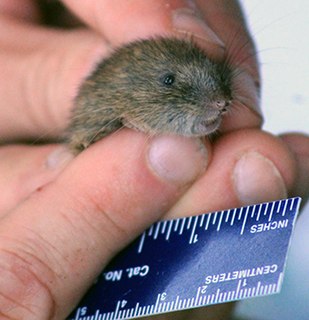
The Puerto Rican nesophontes, or Puerto Rican shrew, is an extinct eulipotyphlan endemic to Puerto Rico.

The northern collared lemming or Nearctic collared lemming, sometimes called the Peary Land collared lemming in Canada, is a small lemming found in Arctic North America and Wrangel Island. At one time, it was considered to be a subspecies of the Arctic lemming. Some sources believe several other species of collared lemmings found in North America are actually subspecies of D. groenlandicus.

The bare-bellied hedgehog, also known as the Madras hedgehog, is a species of hedgehog that is endemic to dry arid regions and scrubby jungles in southeastern India. As it was believed to be rare, it was formerly listed as Vulnerable by the IUCN. It is now known to be locally common in the Indian states of Andhra Pradesh and Tamil Nadu, resulting in its new listing as a species of Least Concern. Hedgehogs are protected species under schedule IV of Wildlife Protection Act (1972).

The Harenna shrew is a white-toothed shrew found only in one location in the Bale Mountains in southern Ethiopia. It occurs within an area of less than ten square kilometres, and is listed as a critically endangered species, due to habitat loss and a restricted range.

Nesophontes, sometimes called West Indies shrews, is the sole genus of the extinct, monotypic mammal family Nesophontidae in the order Eulipotyphla. These animals were small insectivores, about 5 to 15 cm long, with a long slender snout and head and a long tail. They were endemic to the Greater Antilles, in Cuba, Hispaniola, Puerto Rico, the United States Virgin Islands, and the Cayman Islands.

The white-footed vole is a species of rodent in the family Cricetidae. It is found only in the United States. Its natural habitat is temperate forests.
Mackilligin's gerbil also known as Mackilligin's dipodil, is a species of rodent in the family Muridae. It occurs in the southeastern deserts of Egypt and Sudan, around the area of the Halaib Triangle. It has been grouped with Dipodillus nanus, but is now considered specifically distinct.

Tate's shrew rat is a species of rodent in the family Muridae. It is found only in central Sulawesi, Indonesia, where it has been recorded on Mount Latimodjong, Mount Tokala, and Mount Nokilalaki. The species is named after American zoologist George Henry Hamilton Tate.

The Indian gerbil also known as "antelope rat", is a species of rodent in the family Muridae.

The western Cuban nesophontes is an extinct species of mammal in the family Nesophontidae. It was found on Cuba and Hispaniola. It was recently discovered to include three previously thought species: N. submicrus, N. longirostris, and N. superstes.
The St. Michel nesophontes is an extinct species of mammal in the family Nesophontidae. It was endemic to Hispaniola.
The Haitian nesophontes is an extinct species of mammal in the family Nesophontidae. It was endemic to Hispaniola in the Caribbean.

The greater Cuban nesophontes is an extinct species of eulipotyphlan that was native to Cuba. It is thought that the introduction of rats lead to its demise.
The southeastern xanthurus rat, is a rodent of the genus Rattus.
The Cayman nesophontes is an extinct eulipotyphlan of the genus Nesophontes that was once endemic to the Cayman Islands ; the animal lived in the island montane forest/brush endemic to the Cayman Islands and was an insectivore. It is known from subfossil remains, that bear bite marks attributed to crocodiles, collected from caves, sinkholes and peat deposits on the Islands between the 1930s and the 1990s. It was named in 2019.









